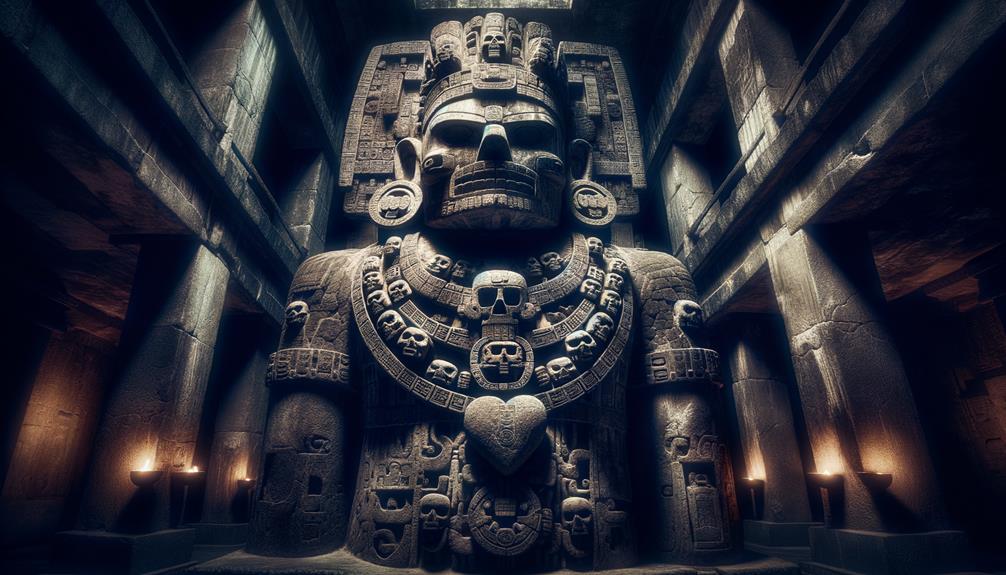Nearly five centuries ago, the towering Coatlicue statue emerged, sparking awe and trepidation among the Mexica people. Gazing upon her fierce countenance adorned with serpentine skirts and a necklace of human hearts, I'm struck by her embodiment of the cyclical forces of life and destruction. Coatlicue transcends mere motherhood; she is the primordial power birthing gods and monsters alike. Her tale, interwoven with feminine resilience and cosmic equilibrium, invites us to unravel her profound impact on the Mexica worldview and the enduring allure of mythology. What enigmas might this Mother of Gods still harbor?
Origins and Mythology
In Aztec lore, Coatlicue represents the primordial mother figure—the embodiment of creation and fertility. Her legendary journey began with an unconventional conception, bearing Huitzilopochtli, the fierce war deity, after miraculously becoming pregnant from an obsidian knife.
But Coatlicue's story doesn't end there. She also gave birth to Coyolxauhqui and 400 other offspring, each symbolizing celestial and earthly elements. The family drama that unfolded mirrors a classic hero's tale. Coyolxauhqui's defiance led to her dismemberment by Huitzilopochtli, transforming her into the moon goddess. This cosmic realignment highlights the intricate interplay of life and death within Aztec mythology.
As the mother goddess, Coatlicue epitomizes the perpetual cycle of creation and destruction. She sits at the heart of Aztec cosmology, embodying the rhythms of existence itself. Her narrative offers profound insights into the nature of life, reflecting the eternal dance of birth, conflict, and renewal.
Symbolism and Iconography
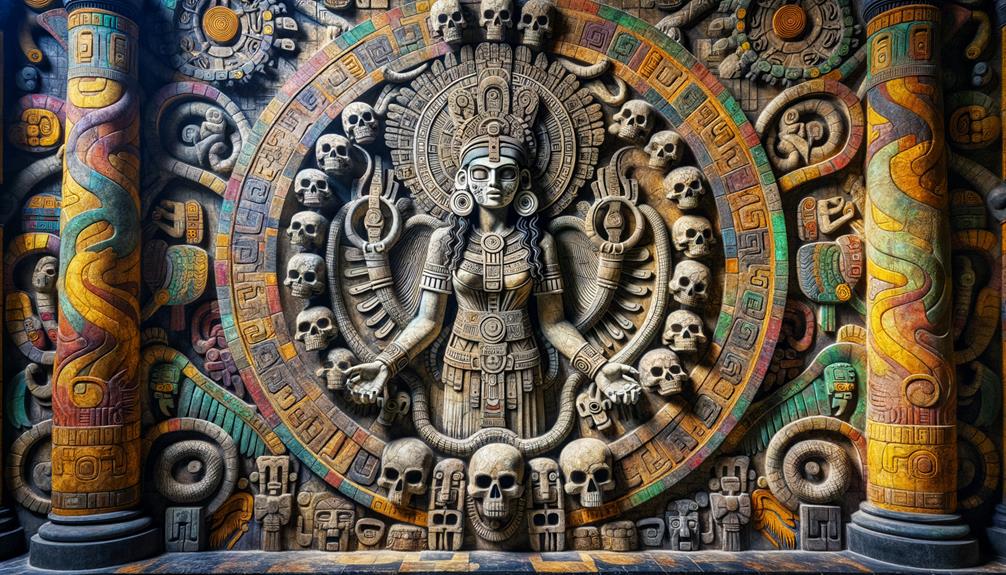
Coatlicue's terrifying features, strung with a necklace of human hands, hearts, and skulls, capture the opposing forces of creation and destruction in Aztec cosmology. The Coatlicue Stone Sculpture, housed at the National Museum of Anthropology, personifies the intricate symbolism deeply rooted in Aztec culture. This deity, adorned with a skirt of serpents and known as the 'Snake Woman' in Nahuatl, represents the eternal cycle of life and death.
Witnessing Coatlicue's presence evokes a visceral reaction to her multifaceted iconography:
- Clawed Hands and Feet: These menacing appendages signify her dominion over death and the underworld realms.
- Pendant Breasts: Representing her nurturing aspect as the mother of gods, they symbolize fertility and nourishment.
- Necklace of Human Remains: This stark imagery depicts her dual role in creation and destruction, uniting life and death.
Contemporary interpretations highlight Coatlicue's significance beyond just a deity—she personifies the archetype of womanhood and motherhood. According to myth, she miraculously conceived Huitzilopochtli after an obsidian blade pierced her, giving birth amidst chaos. This narrative reinforces her status as a pivotal figure in Aztec mythology, embodying the profound nature of creation juxtaposed against destruction.
Worship and Rituals
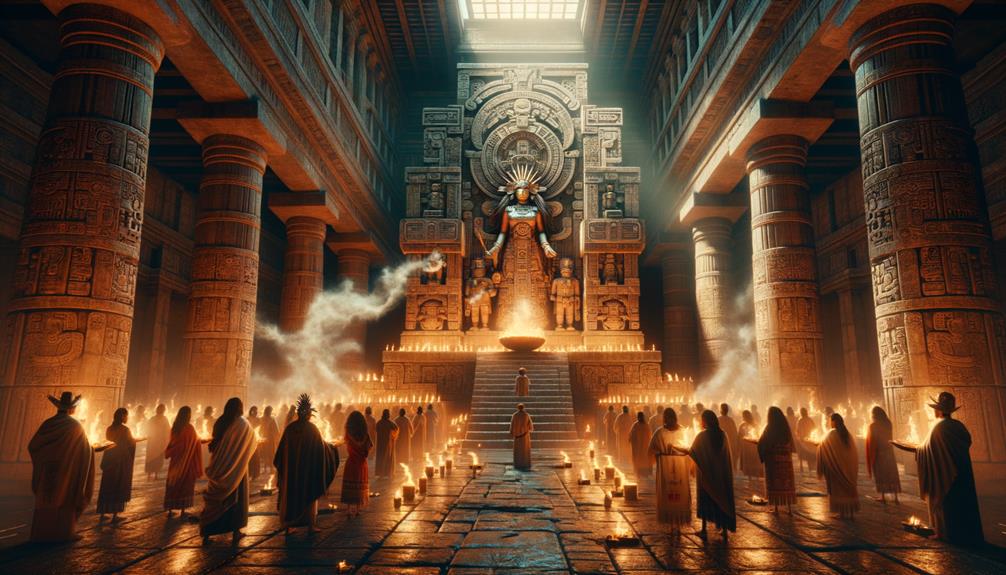
The towering figure of Coatlicue commanded awe among the Aztecs, evident in the rituals dedicated to her. As the patron goddess of women, she symbolized fertility through serpent adornments. The central plaza of Tenochtitlan showcased these sacred practices through stone carvings.
Worshippers brought precious stones, feathers, and flowers, seeking Coatlicue's blessings. In sacred spaces, Aztec priests performed intricate rituals involving dances, music, and prayers. These ceremonies honored Coatlicue's role as the mother of deities and mortals. Blood, incense, and food offerings maintained the delicate equilibrium between creation and destruction – a central Aztec cosmic concept.
For followers, Coatlicue's worship transcended mere ritual, becoming a profound journey. These acts connected them to the mythical essence of life and death cycles she embodied.
Cultural Significance
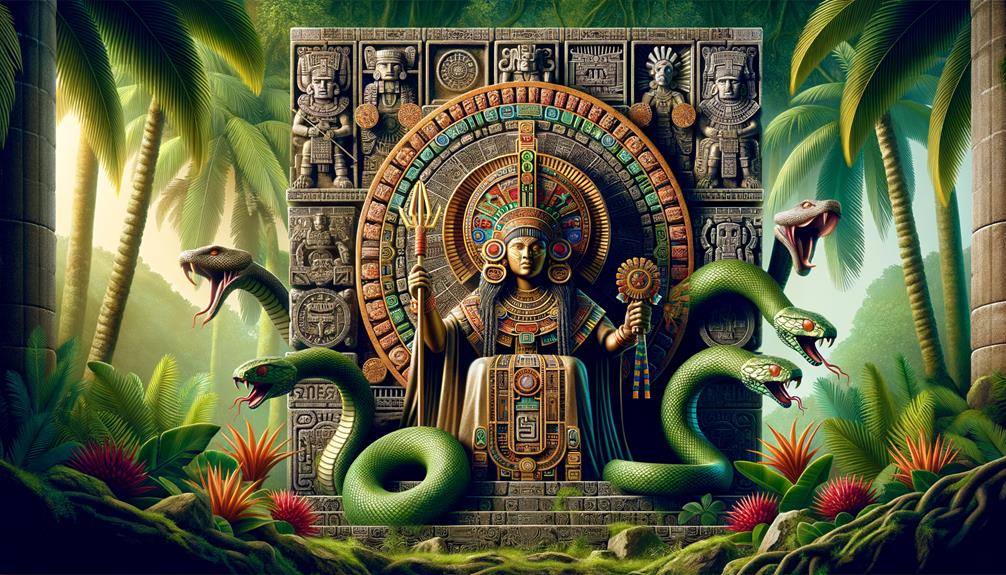
One can't help but be in awe of how Coatlicue, the mighty Mother of Gods, intertwines the intricate fabric of life and death, epitomizing creation and destruction's very essence. As an earth goddess, her presence vividly symbolizes the Mexica's deep reverence for the earth's life-giving force. Coatlicue's duality exemplifies not just her immense power but nature's astonishing equilibrium between nurturing and annihilation.
Her cultural significance resonates profoundly in these ways:
- Feminine Resilience: Coatlicue personifies the strength and vigor of women, especially those facing the ultimate sacrifice of childbirth.
- Motherly Fortitude: As the patron of women who perish in childbirth, she represents the indomitable spirit of motherhood.
- Creation and Fertility: Her role in creation and fertility highlights the Mexica's profound respect for life's cyclical nature, where every ending births a new beginning.
In revering Coatlicue, the Mexica acknowledged existence's profound duality—the seamless interplay of creation and destruction, life and death, resilience and fragility.
Modern Interpretations
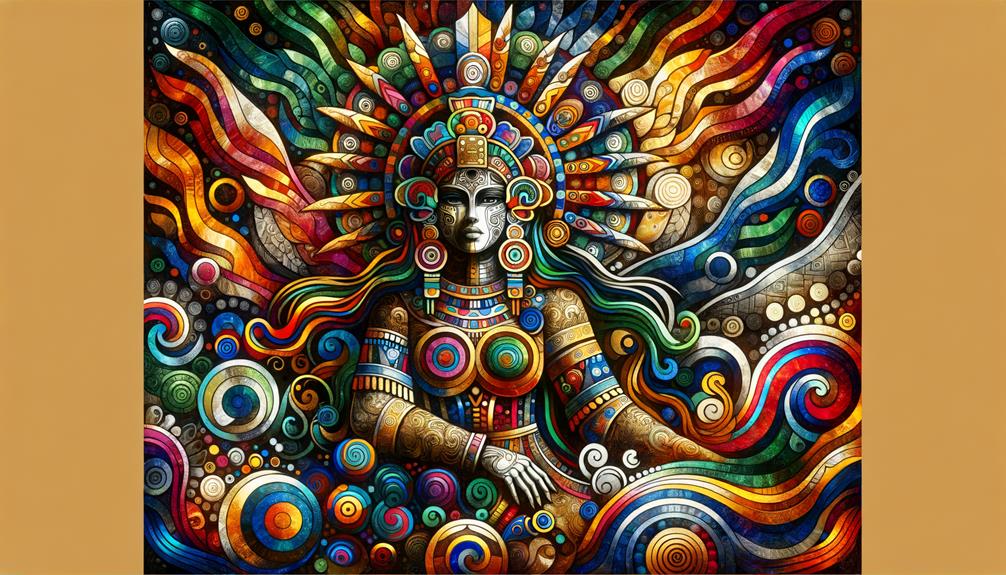
In today's tapestry of Chicana history, Coatlicue emerges as a potent symbol of female resilience and defiance against societal oppression. Through the lens of mythology, her story transforms into an archetypal journey that resonates deeply with contemporary feminist movements.
Coatlicue, the Mother of Gods, transcends her ancient origins, offering a symbolic refuge for those grappling with gender issues and autonomy. Chicana writer Cherrie Moraga highlights Coatlicue and her daughter Coyolxauhqui as powerful female identities challenging traditional narratives. Their myths speak to the eternal cycles of creation and destruction, mirroring the ongoing fight for gender equality and self-determination.
Today, Coatlicue's imagery continues to inspire conversations about fertility, strength, and endurance. As a cultural touchstone, she champions the spirit of women refusing to be silenced. Through Coatlicue, we find affirmation of resilience and the unyielding quest for autonomy amid adversity.
Frequently Asked Questions
Is Coatlicue the Mother of the Aztec Gods?
Coatlicue, the powerful Aztec deity, birthed the legendary Huitzilopochtli amid cosmic turmoil, symbolizing a hero's journey through divine maternal strength and sacrifice. Her essence intertwines creation and destruction, embodying life's intricate duality.
How Did Coatlicue Become Pregnant With Huitzilopochtli?
According to Aztec mythology, Coatlicue miraculously conceived Huitzilopochtli, the mighty war god, after an obsidian knife fell into her womb. This unexpected pregnancy sparked cosmic conflicts, setting the stage for the birth of a divine warrior destined to shape the fate of civilizations.
Why Was Coatlicue Killed?
Coatlicue's own daughter, Coyolxauhqui, turned against her in a treacherous act. Coyolxauhqui rallied her 400 siblings who couldn't accept Coatlicue's divine pregnancy, fearing the change it represented. This betrayal led to Coatlicue's tragic demise and the emergence of Huitzilopochtli.
Who Was the Aztec Mother Goddess?
At the heart of Aztec mythology lies Coatlicue, the earth mother, embodying fertility's creative force and fierce maternal instincts. She weaves the intricate tapestry of life and death, an eternal dance of renewal and destruction.

